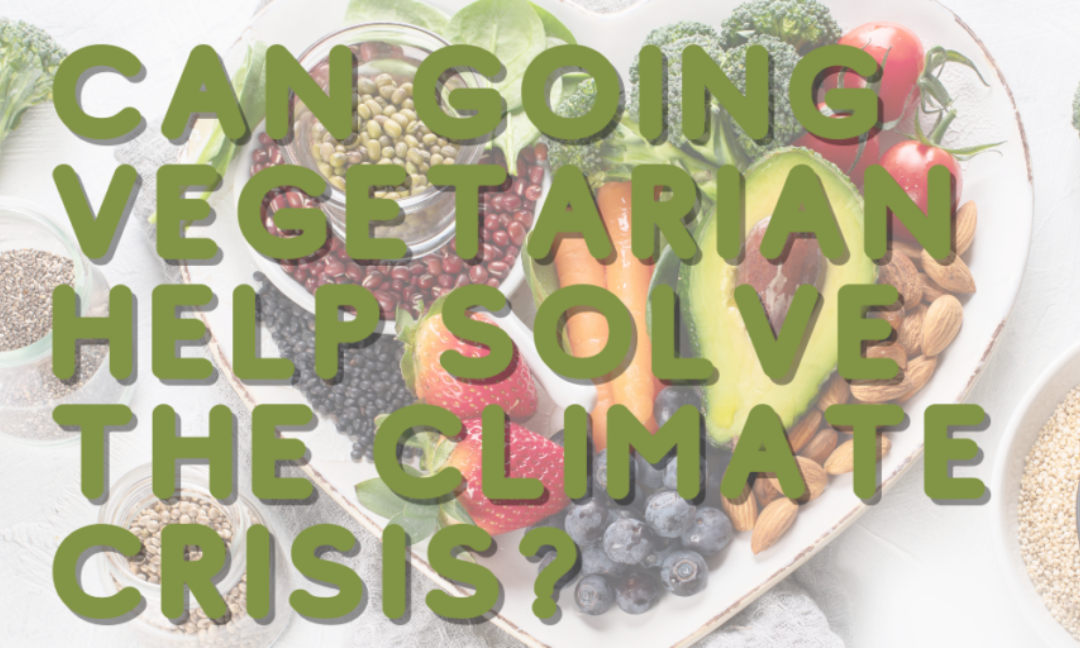Can Going Vegetarian Help Solve the Climate Crisis?
Written By: Emily Usprich-Couture
Edited By: Emily Usprich-Couture
Graphic Design: Emily Usprich-Couture
Published By: Samantha Porte
Can more people going vegan/vegetarian help solve the climate crisis? There are many impacts of both crop and livestock farming that need to be considered.
Crop Farming
As the livestock and human population grows, more farmland is needed. This farmland is often where a forest once was. An example of this is the Amazon being destroyed to make room for soy farms. This negatively impacts wildlife, the ecosystem, and the environment. While crops do absorb carbon dioxide, the emissions from farming equipment often outweigh the absorbed carbon. Additionally, farming is a water guzzler. Growing crops can use a lot of water, fortunately, it uses much less water than livestock. Without livestock we wouldn’t need to grow as much food, this decreases water usage by a lot. Where your food comes from has an impact on your water footprint as well. The use of pesticides, inorganic fertilizers, etc. affect the environment negatively. Runoff of these chemicals can contaminate waters, thus harming wildlife.


The Impact on the Environment
There are many types of farming and a farmer has to make countless decisions that impact the environment. Monoculture is a common problem. Monoculture is when only one crop type (e.g. only soy) is grown in a given space. Monoculture can destroy wildlife and insect habitats. The destroyed habitats lead to an increased need for pesticides. Another problem is continuous cropping. Continuous cropping is when you plant the same crop in a space every year. This drains the soil’s nutrients and lowers the soil quality. It also lowers the quality of what you are growing and disrupts natural pest cycles resulting in an increased use of pesticides. The use of inorganic fertilizers is also a problem. An inorganic fertilizer is a fertilizer that comes from non-living matter. These fertilizers can make the soil more acidic because of the increased nitrate. Plants need nitrogen, but an excess of nitrogen leaves the soil acidic. Additionally, the runoff can contaminate water which harms wildlife (both aquatic and land animals). It also can ruin water for human use. Industrial Crop Processing (or industrial farming) is another big problem. According to the Natural Resources Defense Council, industrial crop processing is “large-scale, intensive production of crops” often using chemical fertilizers and a heavy use of pesticides. Crop harvesting also heavily relies on machinery. This creates lots of carbon dioxide in the atmosphere. Any downstream ecosystems are negatively affected by this due to all the chemicals that get in the water.
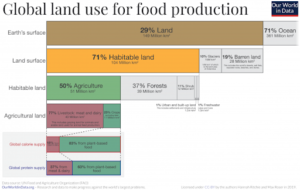
Animal Farming
There are countless issues with the livestock industry. Cattle are a big producer of methane, as they produce it directly and indirectly. Manure makes its way into lagoons. The lagoons then release methane, especially in hot temperatures. There is even a business that sells the methane and markets it as a renewable gas source. Furthermore, feedlot runoff leads to more growth of unwanted aquatic plants and high amounts of nitrogen in water which can harm people and animals. Animals use a lot of the food that we grow. The ratio of feed needed to meat produced is 6.2:1.
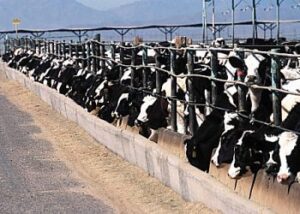
Impact on the Environment
Did you know that livestock contributes roughly 18% of global greenhouse gas emissions? It is one of the top five greenhouse gas emitters. Some argue that eating a steak is worse than driving two cars. Like crop farming, livestock contributes to deforestation. Forests are cut down to create land for animals to graze and live on. Livestock also takes up at least 26% of the earth’s land and about 70% of land used for agriculture. Livestock uses a ton of water as well, it has a much bigger water footprint than any crop. This industry uses roughly the equivalent of 11 900 km³ of water annually. Animals grazing erodes soil and results in top-soil loss.
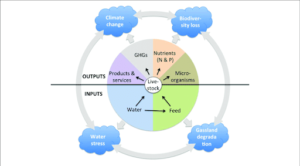
The Toll of Farming Equipment
Heavy farming equipment roughly going over land can permanently damage soil. Conventional tillage is tillage that works all crop residue into the ground by scraping along the surface, often multiple times. This process leaves the soil vulnerable to things like wind and water, because of that, there is often more soil erosion. Conventional tilling can result in the loss of organic soil matter, which is a carbon sink and is done with heavy machinery, leading to carbon emissions. Finally, the use of heavy farming equipment produces carbon dioxide.

Do we have to stop eating meat altogether, or can we eat it in moderation?
A large amount of land is already used by animals. It would be a big ordeal if all of the land was given a different use at once. Many people would lose their careers if no meat was eaten and there would be a negative effect on cultures. Studies have shown that if everyone were to eat the recommended amount of meat and vegetables everyday, there would be a fairly large decrease in greenhouse gas emissions, so eating properly can reduce harmful impacts of agriculture. Due to how popular meat is at the moment, it is best to stop altogether if possible.
If plants are our only food source, will it end up impacting the environment negatively?
Livestock uses much more water than crops, so our water supply could handle the increased food growth. There wouldn’t be that much of an increase in food growth because about 40% of the food we already grow goes to animals. Whether or not plants being our only food source will impact the environment negatively depends largely on the farming practices. As long as things are grown sustainably, there should not be a negative impact. Some sustainable practices include: organic growth and crop rotating. The state and health of soil would probably not deteriorate because animals grazing is a big contributor to top-soil loss and soil erosion, and that would be largely decreased. Some extra measures that could be taken to protect soil are limiting things such as conventional tilling. There are still some downsides to this scenario. Some environments would be negatively affected by the loss of animals. One example is the sheep that live in the Scotland Highlands. If you were to take the sheep away, the environment and ecosystem of the highlands could change.
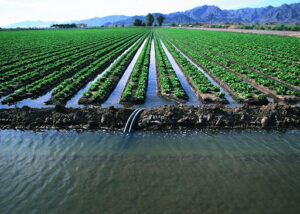
In conclusion, while both crops and livestock can have a negative impact on the environment, the impact of growing crops is much smaller. If you can, try and go vegetarian. If vegetarianism isn’t realistic for you there are many alternatives to look into including: flexitarianism, pescetarianism, pollotarianism, and more.
________________________
Works Cited
link.gale.com/apps/doc/A169749250/GPS?u=ko_k12elm_d60&sid=bookmark-GPS&xid=b93fe1e7
https://link.gale.com/apps/doc/A382493477/SCIC?u=ko_k12hs_d60&sid=bookmark-SCIC&xid=c3963905
https://www.smithsonianmag.com/travel/is-the-livestock-industry-destroying-the-planet-1130807/
link.gale.com/apps/doc/A485672478/GPS?u=ko_k12elm_d60&sid=bookmark-GPS&xid=8e3054cc
link.gale.com/apps/doc/A272651868/GPS?u=ko_k12elm_d60&sid=bookmark-GPS&xid=6fd3994a
link.gale.com/apps/doc/A549582187/GPS?u=ko_k12elm_d60&sid=bookmark-GPS&xid=e9612326
link.gale.com/apps/doc/A272770305/GPS?u=ko_k12elm_d60&sid=bookmark-GPS&xid=38c470www.thecanadianencyclopedia.ca/en/article/agriculture-in-canada
https://www.oecd.org/agriculture/topics/agriculture-and-the-environment/
https://ourworldindata.org/agricultural-land-by-global-diets
https://ourworldindata.org/land-use-diets
https://www.mapleridge.ca/1776/Food-Production
https://www.worldwildlife.org/threats/soil-erosion-and-degradation
https://www.fao.org/3/ca6649en/ca6649en.pdf
https://www.azocleantech.com/article.aspx?ArticleID=838
https://www.greenbiz.com/article/how-much-do-crops-contribute-emissions
https://www.bbc.com/future/article/20160926-what-would-happen-if-the-world-suddenly-went-vegetarian
https://www.truthordrought.com/water
https://www.downtoearth.org/go-veggie/environment
https://www.worldwildlife.org/industries/sustainable-agriculture
https://www.greenpeace.org/usa/victories/amazon-rainforest-deforestation-soy-moratorium-success/

